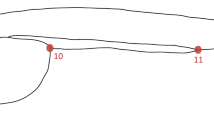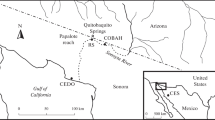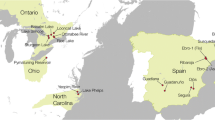Abstract
Endangered species are often maintained in captivity to serve as a safeguard in the event of an extirpation of natural populations. However, wild and captive populations can rapidly diverge in genetic and phenotypic characteristics, including behavior, when maintained in isolation and under different environmental conditions. Here, we compare two populations of the endangered Leon Springs pupfish (Cyprinodon bovinus): a captive population maintained at the Southwestern Native Aquatic Resources and Recovery Center (SNARRC) and the only remaining wild population. Wild fish in the natural Texan Diamond Y desert spring are remnants of a past reintroduction of captive SNARRC fish, which occurred in 1998. The fifteen years of isolation have led to genetic and morphologic differences between the two populations. To assess the behavioral implications of such divergence, we released previously captive C. bovinus into natural habitat and quantified behaviors under natural conditions and in semi-controlled mesocosms and then replicated these conditions with the established natural population. Both populations exhibited similar levels of reproduction, foraging, and agonistic behavior. Despite divergence in genetic and morphometric characteristics, overall behavioral patterns of C. bovinus remained consistent in similar environments. This stability suggests that captive C. bovinus could again be successful establishing in their natural habitat. It is our hope that this investigation will help focus future conservation efforts towards monitoring the persistence of reintroduced C. bovinus in addition to providing a framework for other recovery plans reintroducing captive stock into ancestral habitats.





Similar content being viewed by others
References
Abramofff MD, Magalhaes PJ, Ram SJ (2004) Image processing with ImageJ. J Biophotonics 11:36–42
Araki H, Cooper B, Blouin MS (2007) Genetic effects of captive breeding cause a rapid, cumulative fitness decline in the wild. Science 318:100–103
Armstrong DP, Seddon PJ (2008) Directions in reintroduction biology. Trends Ecol Evol 23:20–25
Black AN, Paciorek T, Snekser JL, Itzkowitz M (2016a) Density-dependent effects of a putative egg predator on the behavior and reproductive success of an endangered species of pupfish. Southwest Nat 61:148–152
Black AN, Snekser JL, Al-Shaer L, Paciorek T, Bloch A, Little K, Itzkowitz M (2016b) A review of the Leon springs pupfish (Cyprinodon bovinus) long-term conservation strategy and response to habitat restoration. Aquatic Conserv: Mar Freshw Ecosyst 26:410–416
Black AN, Seears HA, Hollenbeck CM, Samallow PB (2017) Rapid genetic and morphologic divergence between captive and wild populations of the endangered Leon Springs pupfish, Cyprinodon bovinus. Mol Ecol (in press)
Blanchet S, Páez DJ, Bernatchez L, Dodson JJ (2008) An integrated comparison of captive-bred and wild Atlantic salmon (Salmo salar): implications for supportive breeding programs. Biol Conserv 141:1989–1999
Choi K, Marden J (1997) An approach to multivariate rank tests in multivariate analysis of variance. J Am Statist Assoc 92:1581–1590
Christie MR, Marine ML, French RA, Blouin MS (2012) Genetic adaptation to captivity can occur in a single generation. Nat Acad Sci Proc 109:238–242
Collyer ML, Novak JM, Stockwell CA (2005) Morphological divergence of native and recently established populations of White Sands pupfish (Cyprinodon tularosa). Copeia 1:1–11
Collyer ML, Heilveil JS, Stockwell CA (2011) Contemporary evolutionary divergence for a protected species following assisted colonization. PLoS One 6:e22310
Development Core Team R (2014) R: a language and environment for statistical computing. R Foundation for Statistical Computing, Vienna www.R-project.org
Duvernell DD, Turner BJ (1998) Evolutionary genetics of Death Valley pupfish populations: mitochondrial DNA sequence variation and population structure. Mol Ecol 7:279–288
Echelle AA, Echelle AF (1993) Allozyme perspective on mitochondrial DNA variation and evolution of the Death Valley pupfishes (Cyprinodontidae: Cyprinodon). Copeia:275–287
Echelle AA, Echelle AF (1997) Genetic introgression of endemic taxa by non-natives: a case study with Leon Springs pupfish and sheepshead minnow. Conserv Biol 11:153–161
Echelle AA, Miller RR (1974) Rediscovery and redescription of the Leon Springs pupfish, Cyprinodon bovinus, from Pecos County, Texas. Southwest Nat 19:179–190
Echelle AF, Echelle AA, Bonnel LK, Allen NL, Brooks JE, Karges J (2004) Effects of a restoration effort on an endangered pupfish (Cyprinodon bovinus) after genetic introgression by a nonnative species. In: Lozano-Vilano ML, Contreras-Balderas AJ (eds) Homenaje al Doctor Andrés Reséndez Medina. Universidad Autónoma de Neuvo León, Monterrey, pp 129–139
Edds DR, Echelle AA (1989) Genetic comparisons of hatchery and natural stocks of small endangered fishes: Leon Springs pupfish, Comanche Springs pupfish, and Pecos gambusia. T Am Fish Soc 118:441–446
Fischer J, Lindenmayer DB (2000) An assessment of the published results of animal relocations. Biol Conserv 96:1–11
Frankham R (2008) Genetic adaptation to captivity in species conservation programs. Mol Ecol 17:325–333
Fraser DJ (2008) How well can captive breeding programs conserve biodiversity? A review of salmonids. Evol Apps 1:535–586
Gumm JM, Snekser JL, Itzkowitz M (2008) Conservation and conflict between endangered desert fishes. Biol Lett 4:655–658
Gumm JM, Snekser JL, Leese JM, Little KP, Leiser JK, Imhoff VE, Itzkowitz M (2011) Management of interactions between endangered species using habitat restoration. Biol Conserv 144:2171–2176
Hartup BK, Olsen GH, Czekala NM (2005) Fecal corticoid monitoring in whooping cranes (Grus Americana) undergoing reintroduction. Zoo Biol 24:15–28
Heath DD, Heath JW, Bryden CA, Johnson RM, Fox CW (2003) Rapid evolution of egg size in captive salmon. Science 299:1738–1740
Hendrick PW (2001) Conservation genetics: where are we now? Trends Ecol Evol 16:629–636
Hubbs C (1980) The solution to the Cyprinodon bovinus problem: eradication of a pupfish genome. In: Proceedings of the Desert Fishes Council, vol 10, pp 9–18
Kelley JL, Magurran AE, García CM (2006) Captive breeding promotes aggression in an endangered Mexican fish. Biol Conserv 133:169–177
Kennedy SE (1977) Life history of the Leon Springs pupfish (Cyprinodon bovinus). Copeia 1:93–103
Kleiman DG (1989) Reintroduction of captive mammals for conservation. Bioscience 39:152–161
Kodric-Brown A (1995) Does past reproductive history predict competitive interactions and male mating success in pupfish? Anim Behav 50:1433–1440
Kodric-Brown A, Mazzolini P (1992) The breeding system of pupfish, Cyprinodon pecosensis: effects of density and interspecific interactions with the killifish, Fundulus zebrinus. Environ Biol Fish 35:169–176
Koike H, Echelle AA, Loftis D, Van D, Bussche PA (2008) Microsatellite DNA analysis of success in conserving genetic diversity after 33 years of refuge management for the desert pupfish complex. Anim Conserv 11:321–329
Leiser JK, Itzkowitz M (2003) The costs and benefits of territorial neighbours in a Texas pupfish Cyprinodon bovinus. Behaviour 140:97–112
Leiser, J.K., Gagliardi-Seeley, J.L., Wisenden, B.D., Itzkowitz, M. (2015). Promiscuous mating patterns of female Leon Springs pupfish, Cyprinodon bovinus. J Fish Biol. In press
Lema SC, Nevitt GA (2006) Testing an ecophysiological mechanism of morphological plasticity in pupfish and its relevance to conservation efforts for endangered devils hole pupfish. J Exp Biol 209:3499–3509
Martin BA, Saiki MK (2005) Relation of desert pupfish abundance to selected environmental variables in natural manmade habitats in the Salton Sea basin. Environ Biol of Fishes 73:917–107
Mathews F, Orros M, McLaren G, Gelling M, Foster R (2005) Keeping fit on the ark: assessing the suitability of captive-bred animals for release. Biol Conserv 121:569–577
Milot E, Perrier C, Papillon L, Dodson JL, Bernatchez L (2014) Reduced fitness of Atlantic salmon released in the wild after one generation of captive breeding. Evol App 270:2443–2450
Mittelbach GG, Ballew NG, Kjelvik MK (2014) Fish behavioral types and their ecological consequences. Can J Fish Aquat Sci 71:927–944
Seddon PJ (2010) From reintroduction to assisted colonization: moving along the conservation translocation spectrum. Restor Ecol 18:796–802
Seddon PJ, Armstrong DP, Maloney RF (2007) Developing the science of reintroduction biology. Conserv Biol 21:303–312
Snekser JL, Wynne RD, Itzkowitz M (2017) Endangered species interactions suggest a role for personality and behavioral syndromes in conservation efforts. Ethol Ecol Evol 29:85–93
Snyder NF, Derrickson SR, Beissinger SR, Wiley JW, Smith TB, Toone WD, Miller B (1996) Limitations of captive breeding in endangered species recovery. Conserv Biol 10:338–348
Teixeira CP, De-Azevedo CS, Mendl M, Cipreste CF, Young RJ (2007) Revisiting translocation and reintroduction programmes: the importance of considering stress. Anim Behav 73:1–13
U.S. Federal Register (2008) vol 75, pp 1499–14997. This closure remains enforced to date. http://www.fws.gov/policy/library/2008/E8-5632.html. Accessed 8 Feb 2015
Veni G (1991) Delineation and preliminary hydrogeologic investigation of the diamond Y spring, Pecos County. Texas. Report to the Texas Chapter of The Nature Conservancy, San Antonio
Wilcox JL, Martin AP (2006) The devil's in the details: genetic and phenotypic divergence between artificial and native populations of the endangered pupfish (Cyprinodon Diabolis). Anim Conserv 9:316–321
Woodworth LM, Montgomery ME, Briscoe DA, Frankham R (2002) Rapid genetic deterioration in captive populations: causes and conservation implications. Conserv Genet 3:277–288
Acknowledgements
We are grateful for the Section 6 Grant (TX E-150-R) awarded by the Texas Parks and Wildlife Department to fund this project. We thank Matthew Franklin and John Karges of the Nature Conservancy and Nathan Allen of the Fish and Wildlife Service for their unwavering and wholehearted support of this project. We also thank Mike Montagne and Manuel Ulibarri of the Fish and Wildlife Service for their past and current support. Many thanks to the Nature Conservancy for allowing us access to the Diamond Y Spring and for providing us with accommodations near our field sites. All fishes were handled in accordance with stipulations defined in TX Parks and Wildlife permit # SPR – 0812 - 967.
Author information
Authors and Affiliations
Corresponding author
Rights and permissions
About this article
Cite this article
Black, A., Snekser, J.L. & Itzkowitz, M. Preservation of behavior after fifteen years of isolation: comparisons of wild and captive endangered pupfish in their natural habitat. Environ Biol Fish 100, 1517–1525 (2017). https://doi.org/10.1007/s10641-017-0662-6
Received:
Accepted:
Published:
Issue Date:
DOI: https://doi.org/10.1007/s10641-017-0662-6




